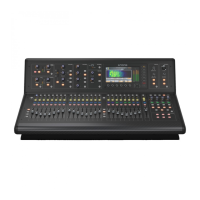88 M32 - Digital Console User Manual 89
Rhythm Delay
The Rhythm Delay, or 4-Tap Delay, provides four delay stages with independent frequency, gain and pan controls. Create
time-based echo eects with the triple delay to increase the sense of stereo separation.
TIME BASE sets the master delay time, which is also the delay time for the rst stage. GAIN BASE sets the gain level of
the rst stage of the delay. PAN BASE sets the position of the rst delay stage in the stereo eld. LO CUT sets the frequen-
cy at which the source signal can begin passing through the delay. HI CUT sets the frequency at which the source signal
can no longer pass through the delay. X-FEED indicates that stereo cross-feedback of the delayed signals is active. MONO
activates a mono mix of both channels for the delay input. FEED adjusts the amount of feedback. FACTOR A controls the
amount of delay time in the second stage of the delay. GAIN A controls the gain in the second stage of the delay. FACTOR
B controls the amount of delay time in the third stage of the delay. GAIN B controls the gain in the third stage of the delay.
FACTOR C controls the amount of delay time in the fourth stage of the delay. GAIN C controls the gain in the fourth stage
of the delay.
Triple Delay
Sometimes called a 3-Tap Delay, the Triple Delay provides three delay stages with independent frequency, gain and pan
controls. Create time-based echo eects with the triple delay to increase the sense of stereo separation.
TIME BASE sets the master delay time, which is also the delay time for the rst stage. GAIN BASE sets the gain level of
the rst stage of the delay. PAN BASE sets the position of the rst delay stage in the stereo eld. LO CUT sets the frequen-
cy at which the source signal can begin passing through the delay. HI CUT sets the frequency at which the source signal
can no longer pass through the delay. X-FEED indicates that stereo cross-feedback of the delayed signals is active. MONO
activates a mono mix of both channels for the delay input. FEED adjusts the amount of feedback. FACTOR A controls the
amount of delay time in the second stage of the delay. GAIN A controls the gain in the second stage of the delay. PAN A
sets the position of the second stage of the delay in the stereo eld. FACTOR B controls the amount of delay time in the
third stage of the delay. GAIN B controls the gain in the third stage of the delay. PAN B sets the position of the third stage
of the delay in the stereo eld.
Stereo Chorus
Chorus samples the input, slightly detunes it and mixes it with the original signal to produce a somewhat thicker, shim-
mering sound. Use it to thicken up background vocals, or to double the sound of brass and woodwind instruments.
Whereas DELAY L / R set the total amount of delay for the left and right channels, WIDTH determines the amount of
modulated delay. SPEED sets the modulation speed, MIX adjusts the balance of dry and wet signals. You can further
sculpt the sound by trimming some of the low- and high-end of the aected signal with the LO CUT and HI CUT rotary
controls. Additionally the PHASE rotary control can tweak the phase oset of the LFO between left and right channels, and
the SPREAD rotary control adjusts how much of the left channel is mixed into the right, and vice versa. Finally the WAVE
rotary control blends between the ‘Danish’ style digital triangular chorus sound and the classic analogue sine wave.
Stereo Flanger
The Flanger emulates the phase-shifting sound (comb-ltering) originally created by applying pressure against the ange
of the reel on a tape recorder. This eect creates a unique ‘wobbly’ sound that is quite dramatic when used on vocals and
instruments.
The controls of this eect are nearly identical to the controls on the Chorus eect block. Additionally, the FEEDBACK can
be adjusted with positive and negative amounts, and also band-limited with the FEED HC (high-cut) and FEED LC (low
cut) rotary controls.
www.theaudiospecialists.eu

